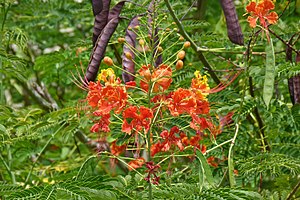Note: This is a project under development. The articles on this wiki are just being initiated and broadly incomplete. You can Help creating new pages.
Caesalpinia pulcherrima
Caesalpinia pulcherrima is a deciduous or evergreen shrub or small tree. Usually without prickles, it can grow up to 5 metres tall. The slender trunk is usually straight and cylindrical and can be free of branches for 100cm or more. It is a multipurpose plant, it is often gathered from the wild for local food and medicinal use.
Contents
- 1 Uses
- 2 Parts Used
- 3 Chemical Composition
- 4 Common names
- 5 Properties
- 6 Habit
- 7 Identification
- 8 List of Ayurvedic medicine in which the herb is used
- 9 Where to get the saplings
- 10 Mode of Propagation
- 11 How to plant/cultivate
- 12 Commonly seen growing in areas
- 13 Photo Gallery
- 14 References
- 15 External Links
Uses
Diarrhoea, Kidney stones, Stomach ache, Urinary bladder, Kidney problems, Gall bladder problems.
Parts Used
Chemical Composition
Common names
| Language | Common name |
|---|---|
| Kannada | ಕೆಂಜಿಗೆ Kenjige, ರತ್ನಗಂಧಿ Ratnagandhi |
| Hindi | Guletura |
| Malayalam | Settimandaram |
| Tamil | Mayurkonrai |
| Telugu | Ratnagandhi |
| Marathi | Sankasur |
| Gujarathi | |
| Punjabi | |
| Kashmiri | |
| Sanskrit | Sidhakya |
| English | Peacock Flower, Pride of Barbados |
Properties
Reference: Dravya - Substance, Rasa - Taste, Guna - Qualities, Veerya - Potency, Vipaka - Post-digesion effect, Karma - Pharmacological activity, Prabhava - Therepeutics.
Dravya
Rasa
Guna
Veerya
Vipaka
Karma
Prabhava
Habit
Identification
Leaf
| Kind | Shape | Feature |
|---|---|---|
Flower
| Type | Size | Color and composition | Stamen | More information |
|---|---|---|---|---|
| {{{5}}} |
Fruit
| Type | Size | Mass | Appearance | Seeds | More information |
|---|---|---|---|---|---|
Other features
List of Ayurvedic medicine in which the herb is used
Where to get the saplings
Mode of Propagation
How to plant/cultivate
An evergreen plant in the tropics, in cooler but frost-free areas it is more likely to become deciduous whislt in areas with occasional frosts it can survive as a perennial plant, dying down to ground level in the cold season but regrowing with the warmer weather.[4]
Commonly seen growing in areas
Photo Gallery
References
- ↑ [Chemical]
- ↑ Common names
- ↑ [Morphology]
- ↑ Cultivation
External Links
- [ ]
- [ ]
- [ ]
- Ayurvedic Herbs known to be helpful to treat Diarrhoea
- Ayurvedic Herbs known to be helpful to treat Kidney stones
- Ayurvedic Herbs known to be helpful to treat Stomach ache
- Ayurvedic Herbs known to be helpful to treat Urinary bladder
- Ayurvedic Herbs known to be helpful to treat Kidney problems
- Ayurvedic Herbs known to be helpful to treat Gall bladder problems
- Herbs with Young seeds used in medicine
- Herbs with Flowers used in medicine
- Herbs with common name in Kannada
- Herbs with common name in Hindi
- Herbs with common name in Malayalam
- Herbs with common name in Tamil
- Herbs with common name in Telugu
- Herbs with common name in Marathi
- Herbs with common name in Sanskrit
- Herbs with common name in English
- Habit - Evergreen shrub
- Index of Plants which can be propagated by Seeds
- Index of Plants which can be propagated by Softwood cuttings
- Herbs that are commonly seen in the region of Tropical dry to moist forest
- Herbs
- Pages without herbs images




